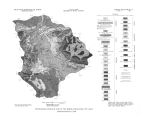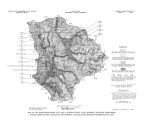| OCR Text |
Show Discharge The principal manmade discharge of water from the consolidated rocks in the area is through the extensive mine workings in the vicinity of Park City ( fig. 7). The amount of water discharged by the few small- capacity wells that penetrate the consolidated rocks is only a very small part of the total discharge. Natural discharge is through numerous springs, mostly around the margins of the valleys, and through direct infiltration into the unconsolidated deposits in the valleys. The total discharge from mine tunnels is estimated as at least 50 cfs ( cubic feet per second) or 36,000 acre- feet per year. The discharge of the Spiro Tunnel, near Park City, was reported in 1935 as about 15 cfs and " a rather steady flow" for several years ( G. H. Taylor, written commun., 1935). The flow of Drain Tunnel Creek, which consists principally of the discharge of the Ontario No. 2 Drain Tunnel, is measured at a weir about 5 miles downstream from the mouth of the tunnel ( fig. 2). The losses to evapotranspiration between the tunnel mouth and the weir probably equal or exceed any gains from ground- water discharge to the stream. The average discharge of Drain Tunnel Creek is 15.9 cfs ( 18 years of record). The drainage from the Mayflower Mine enters Drain Tunnel Creek downstream from the above- mentioned weir; in 1967- 68 the discharge of the Mayflower Mine drainage was estimated as about one- half that of Drain Tunnel Creek at the weir. Smaller amounts of water are discharged from other tunnels in the area. The water discharged from the Alliance Tunnel ( quantity unknown) provides the municipal supply for Park City; the discharge from the other tunnels is used for irrigation in Parleys Park and Heber Valley. A large but undetermined amount of water is discharged from the consolidated rocks through numerous springs. In 1968, the Utah State Engineer's records included claims to water from about 250 springs that discharge water from the consolidated rocks. The springs are nearly all associated with fractures or solution openings. The largest springs in the area flow from solution openings in the limestones of Pennsylvanian and Mississippian age. For example, three springs near the mouth of Snake Creek Canyon discharged about 13 cfs from the limestones during the summer of 1967. An unusual hydrologic feature of Heber Valley is a group of thermal springs near the town of Midway. Although the springs are located on the Snake Creek alluvial fan, and are underlain in part by alluvium, their source is deep seated and they represent discharge from the consolidated rocks. A more detailed discussion of the thermal springs has been given elsewhere ( Baker, 1968), and they will be described only briefly here. Most of the thermal springs do not flow and are known locally as " hot pots." The typical hot pots are small pools of warm water that occupy shallow depressions in the tops of mounds of calcareous tufa ( fig. 8). Seventeen hot pots in the area have been examined by the writer. Four of the hot pots are artificially discharged to supply water to swimming pools at resorts, 2 pots occasionally overflow, and the other 11 discharge water at the land surface only by evaporation, although some thermal water may be discharged into the valley fill in the subsurface. The temperature of the water in the 13 pots without artificial discharge ranges from 12° to 34° C ( 54°- 94° F), and the highest temperatures are in the 2 pots that occasionally overflow. Water temperature in the 4 pots that are artificially discharge ranges from 38° to 40° C ( 100°- 104° F). Addition of heated water from below to many of the pots is very slow, and the water of a few pots is lower than that properly classified as " thermal." 21 |
































































































